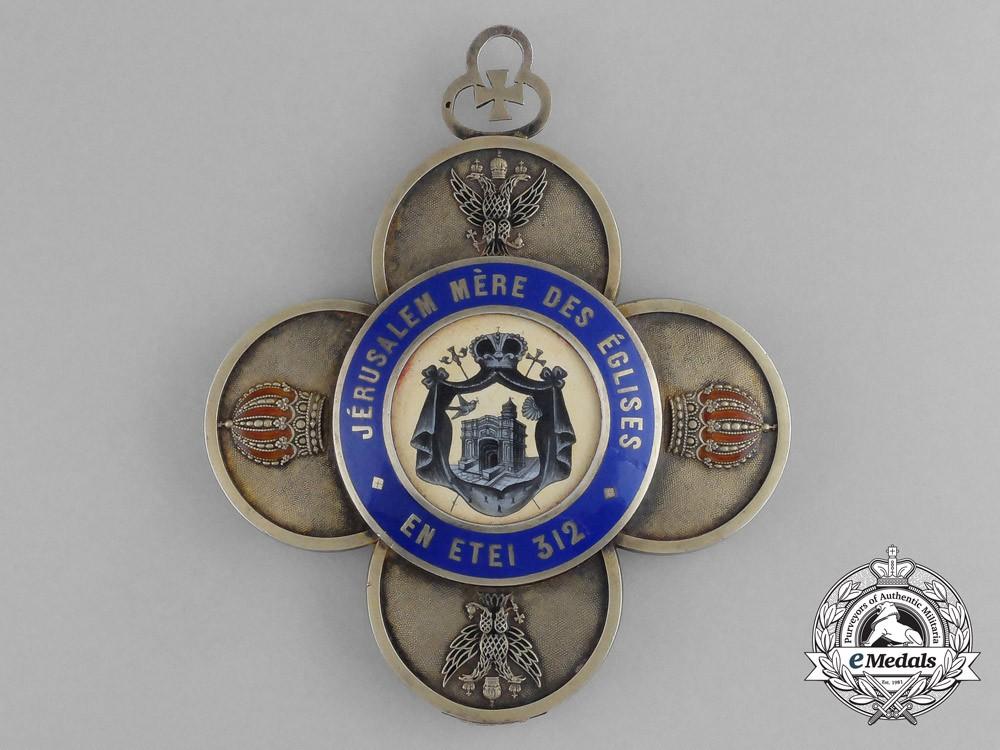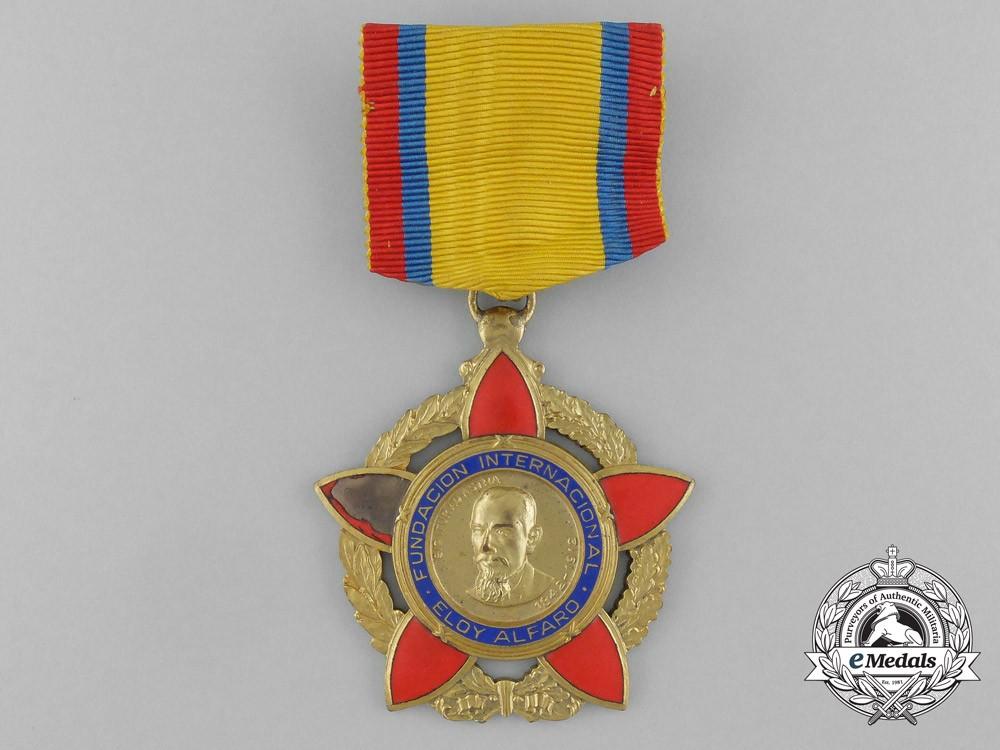-
Posts
4,807 -
Joined
-
Last visited
-
Days Won
12
Content Type
Profiles
Forums
Blogs
Gallery
Events
Store
Everything posted by Gordon Craig
-
Jannis, Glad to hear that you have found a book that describes these awards. Would you please tell me the title of the book and where I could buy a copy. Perhaps I did not explain myself when I asked about the two awards pictured above. While they are the same shape they are not the same award. The painting in the medallion is different and one has the Jerusalem Cross in the arms while the other has two crowns and two double headed eagles. The cross with the crowns appears to be the Order of the Orthodox Crusaders. What is the other cross with the Jerusalem cross in the four arms? Regards, Gordon
-
Jannis, Good luck in your search. I hope that you get an answer from Jerusalem. If you are still trying to add to your collection in this Order and have not looked at emedals I would suggest it as one source. Regards, Gordon https://www.emedals.com/an-order-of-the-orthodox-crusaders-of-the-patriarchy-of-jerusalem-grand-cross
-
Jannis, Thanks for the additional information. Your assumption that the older crosses did not have laurels and newer ones did seems reasonable. It would also seem that the medallion was also added at a later date. I found the following on a page in the Library of John F. Kennedy. It is interesting to note who bestowed this Knights Cross on Jackie Kennedy. Perhaps contacting the office in Jerusalem might help you resolve your question. https://www.jfklibrary.org/asset-viewer/archives/JFKSG/JFKSG-MO-1963-1711-2c/JFKSG-MO-1963-1711-2c Regards, Gordon About Museum Artifact Accession Number: MO 63.1711.2c Collection: Gifts from Heads of State Title: Grand Cross of the Equestrian Order of the Holy Sepulchre of Jerusalem Maker: Maker unknown Medium: Gold, enamel, textile Dimensions: 3 3/4" x 1 5/8" Description: Gold and black enamel Latin crowned cross surrounded by green enamel laurel wreath. The cross hangs as a pendant from a red ribbon. The cross grants membership for Mrs. John F. Kennedy into, and is the symbol of rank of Knight Grand Cross in the Equestrian Order of the Holy Sepulchre of Jerusalem. Historical Note: This award was bestowed upon First Lady Jacqueline Kennedy by His Beatitude Benedictos I, Greek Orthodox Patriarch of Jerusalem, at the White House on October 6, 1961. Knight Grand Cross is one of the five classes of rank bestowed by the Equestrian Order of the Holy Sepulchre of Jerusalem. Membership in the Order is reserved solely for practicing Roman Catholics. The Equestrian Order of the Holy Sepulchre of Jerusalem can trace its origins to Godfrey de Bouillon of the first Crusade, who gathered around him a group of knights who were entrusted with the protection of the religious Chapter of Canons who were present at the Holy Sepulchre of Christ. For twenty years, these knights, and those who came to join their number, protected the Christian presence at the Holy Sepulchre, taking as their banner the red Jerusalem cross popularized by the crusading knights. Rights Copyright Status: Donated to the United States Digital Identifier: JFKSG-MO-1963-1711-2c Gifter: His Beatitude Benedictos I, Greek Orthodox Patriarch of Jerusalem Related Records: Presentation Chest for the Grand Cross Grand Cross of the Equestrian Order of the Holy Sepulchre of Jerusalem Star Presentation Chest for the Grand Cross Grand Cross of the Equestrian Order of the Holy Sepulchre of Jerusalem Grand Cross of the Equestrian Order of the Holy Sepulchre of Jerusalem Star Archival Creator: National Archives and Records Administration. Office of Presidential Libraries. John F. Kennedy Library. (04/01/1985- )
-
Johannis, An interesting question. I would be interested in knowing the answer as well. Since you are in Greece have you enquire of the Orthodox church about this simple cross in relationship to the one with Laurels? Sorry for the question but I had to ask. I've posted a picture of the cross with laurels for comparison. Regards, Gordon
-
Duncan, It takes some expertise in using a UV-Light when trying to date/authenticate medal ribbons. Or uniforms for that matter. Different results will be encountered depending on the age/period of the ribbon. Imperial, Third Reich or country. There are a number of styles of UV-Lights and they may give different results as well. Also, the purpose that the UV-Light was designed for. Here is a link to a site that discusses some UV-Lights. https://uvcanada.ca/?gclid=Cj0KCQjw0oCDBhCPARIsAII3C_G4l6M_knQpPwEIcYR0gg9Ls08kPI-k5YTPsxf0Qkx0zm1hrH_ifrUaAjA9EALw_wcB Before buying a UV-Light I would suggest some research on these devices and talking to someone who uses one on a regular basis. I use a fluorescent fixture with an 18 inch T8 bulb rated at 15 watts. It suits my purposes but I have never compared it to other UV-lights someone uses for the same purpose. Regards, Gordon
-
Gentlemen, I'd like to add a small comment here about Third Reich materials and their reaction to a UV-Light. About mid war more synthetic materials were used in cloth used in ribbon material and some other applications. This has led to a lot of confusion as to the accuracy of using a UV-Light to "date" a specific artifact. The solution seems to be a lot of experience in using a UV-Light on materials from many eras. Regards, Gordon
-
ThaiDave, Great website and an excellent reference. Thanks for posting the link to your site. Regards, Gordon
-

Schutzenverein
Gordon Craig replied to Gordon Craig's topic in Germany: Post 1945: Bundesrepublik & DDR
Bombarder, Interesting display. You are lucky to have shooting medals that can be attributed to an individual. The unnamed medals were used by all of the shooting clubs in Germany and could be awarded in any way the club chose. They can not be attributed to any specific event or competition unless that is indicated on the back. Regards, Gordon -
Utku, I buy from emedals but like any dealer you need to study their pictures to make sure that what they have for sale is what you actually want. Their prices are high but if you wish to return an item after you receive it they are easy to deal with. If you want comments on the crss you wish to buy from emedals why not post a link to the cross here. Regards, Gordon
-
Arnhembobby, I only found one James Cochrane listed in the Library and Archives and it is probably not your man. Here is the link to him at the LAC. https://www.bac-lac.gc.ca/eng/discover/military-heritage/military-medals-1812-1969/Pages/item.aspx?IdNumber=17294& I am not well versed in this medal but one way to trace those who were awarded bars for the the Fenian Raids is through their applications for the bounty paid to those who served. This link will lead you to two applications from men who served in the Militia Regiment of Kings County Nova Scotia. This method would only be useful if your man applied for the Bounty. http://freepages.rootsweb.com/~dimcl/genealogy/fenianraidservice.html Regards, Gordon
-
Utka, Welcome to the GMIC. Like most collectors I buy what interests me and will provide me with hours of fun in the research of the artifact. This often leads me to start a new collection on a specific artifact/area that I have not collected/researched. This can get pricey so there are some areas of interest where I have only been able to add the less expensive artifacts. This doesn't interfere with extensive research though. As for finding one book that covers all aspects of one medal, that is possible but I would advise that when you decide to focus on one medal you buy as many books in this area as you can find. There are unintentional mistakes in most books and the correct answer may be in a different book or a later edition of the same book. Good luck in your quest for assistance. Regards, Gordon
-
Gentlemen, If you google this medal it comes up as being from Ecuador. However, this medal is also awarded by Panama. I have seen it advertised for sale as being from either country and the medal appears identical in each case. I am researching Corvette Capitain Hector Abdelnour of the Venezuelan navy who was awarded the subject medal by Panama for his services in the City of Panama on June 25, 1959. I would like to know if the medal issued by the two countries is different in design and if not why do Ecuador and Panama issue the same medal? Regards, Gordon
-

Carl Poellath paperbag
Gordon Craig replied to Bombarder's topic in Germany: Post 1945: Bundesrepublik & DDR
Bombarder, I would say post war. I've never seen a BRD post war award come in a paper bag. This bag is quite different from the war time ones and I don't know what would have come in it. This site has one for sale but they don't really say what it is. https://derrittmeister.com/product/carl-poellath-kg-award-packets-bavaria/ Possibly try posting this on the BRD sub forum on the WAF. (Wehrmacht Awards Forum) Regards, Gordon -

Unknown german commemorativ coin/prize
Gordon Craig replied to Bombarder's topic in Germany: Post 1945: Bundesrepublik & DDR
Bombarder, I have never heard of a list of names for these badges but it would certainly be interesting if there was one. Regards, Gordon -
Good Day, I am trying to ascertain what uniform tunic the SAC buttons in the attached photo were worn on. The gold one on your left is flat while the gold one on the right is domed. The gold one on the right has been polished so many times that the South African Constabulary title is just a blur and hard to read. The silver ones were made by V&R BLAKEMORE BIRMINGHAM, the flat gold button was also made by BLAKEMORE. The gold domed one was made by the ARMY & NAVY COOP SOCIETY LD. Regards, Gordon
-

Award roll for Polonia Restituta?
Gordon Craig replied to JohanH's topic in Central & Eastern European States
Gentlemen, This question has been asked in the past and answer has been that there is no known list. Regards, Gordon -
Good morning, I come seeking info on the Hlinka Guard and the Hlinka Transport Guard daggers. The only picture that I have seen identifying these two daggers is on the cover of A Guide to Military Dress Daggers Volume III. He shows two Hlinka daggers, in the scabbard, that appear to be identical. He identifies them as Hlinka Guard and Hlinka Transport Guard daggers but does not include them in his book. This leaves to believe that the difference between the two must be the blade but without a picture that clearly identifies the difference between the two I can not be sure. I'd appreciate any help I can receive. Pictures of originals of eiither dagger would be appreciated. Regards, Gordon
-
mdejong, Two suggestions. Better pictures of the medal would be very helpful and posting your question on the Wehrmacht Awards Forum https://www.wehrmacht-awards.com/forums/forum/wehrmacht-era-militaria/political-organizations/11648409-blood-order-collection-book-volume-two might get you an answer to your question. Regards, Gordon
-

Johannesburg Zuid-Afrikaansche Rijdende Politie (ZARP) assistance please
Gordon Craig replied to Medic2's topic in Africa
Medic2, Welcome to the forum. While I am familiar with the 2nd Boer War period I am unfamiliar with the term GGF. Perhaps you could let me know what it stands for? Regards, Gordon -
Perhaps the unhappy Poles? https://en.wikipedia.org/wiki/Poznań_protests_of_1956#:~:text=The sign reads "We demand bread!"&text=The Poznań protests of 1956,of the Polish People's Republic. Regards, Gordon
-

Youth labour actions badges (Yugoslavia)
Gordon Craig replied to BalkanCollector's topic in Southern European & Balkan States
My Hungarian collection is all packed away but when I find time I'll dig out what I have and do a thread on them. Regards, Gordon









.thumb.jpg.8dc5b28fa2c8d8aa5f78a30a5d2c578c.jpg)